Dark Spots On Pothos' Leaves...What's Wrong? Please Help!
Hi Everyone,
I have a pothos that started as cuttings in a vase and eventually rooted over about 5 months.
I noticed brown spots on two of the leaves before I repotted the plant in September and thought it was due to the plant being too close to the window so I didn't really think it was a problem.
Today I noticed some more of the leaves (now about 6 total) have the same brown spots and I see small impressions that look like they will eventually turn into the bigger brown spots on some more leaves.
Does anyone have any idea why this is happening and how I can fix it? Should I take the leaves with the spots off?
Thanks.
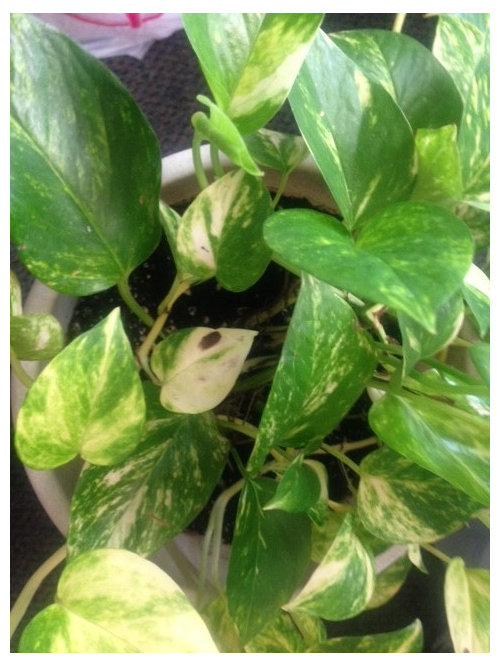
Comments (67)
pirate_girl
11 years agoI too live in NYC. My windows are never closed, I leave 'em open at least an inch on the bottom always. My sills are lined w/ plants, I haven't lost anything to the cold yet. While I don't have lots of tropicals (they're in middle of the room), I've got some & all my Hoyas are at or near the windows.
Pothos don't need strong light near the window, I grow them in cups of water in my bathroom, across the room from the window, they do fine.
Pothos leaves get ratty sometimes, when they do, just pluck off that single leaf & they're fine. Next time, I'd use a smaller pot for the Pothos, that pot may be a bit big for them which can contribute to overwatering problems.
PS: It's not unusual for a day or 2 to pass before anyone responds to a thread, that's not abnormal.
pirate_girl
11 years agoHi FicusWrangler,
Hasn't happened to me lately, but here's a trick I use which has saved a whole lot of time!!
When you're done writing your text, copy it as if you're going to paste it into another doc. This way, if something goes awry (unless you close the program) it'll be the last thing in your computer's "memory" so that once things calm down & you get back to a clear screen, you can invoke "paste" & there's your text.
Sometimes I write long responses & would hate to have to re-type them. I was a professional word processor for many years & it occurred to me to do this. Unless you close the program, the Copy/Paste will stay in memory until you perform the next one.
Hope it helps!
(PG) Karen
Related Professionals
Holly Springs Landscape Architects & Landscape Designers · Carson Landscape Architects & Landscape Designers · Glen Ellyn Landscape Architects & Landscape Designers · Otsego Landscape Architects & Landscape Designers · Wareham Landscape Architects & Landscape Designers · Belmont Landscape Contractors · Chattanooga Landscape Contractors · Plainview Landscape Contractors · San Pedro Landscape Contractors · Weymouth Landscape Contractors · Winchester Landscape Contractors · Antioch Landscape Contractors · Oxon Hill Landscape Contractors · Golden Valley Landscape Contractors · Wolf Trap HandymanThe Ficus Wrangler
11 years agoPG, thanks, that's a great idea. I love that handle 'PG' I used to have a cat we called PG - short for Punjab Geronimo. (Don't ask, it's a long story. This was in 1970, if that gives you a clue.)
Re the open window thing, it's your call. Someone who's done a thing definitely trumps someone who hasn't. Just wanted you to be aware of the 40degree mark for tropicals.
Courtney Hayes
8 years agoHi, I've had a golden pothos for a few months now and it's been doing great until I recently noticed it had yellow leaves where it seemed to be getting too much light, (I have it hanging in a macrame hanger) I moved it from a south facing window to a north facing ING window. (In the same room. The room is my living room and it's the brightest room in my house) it then developed some mealybug which I scraped off and sprayed down with a mix of water alcohol and soap. That went away and now a week later I notice all kinda of brown spots in the leaves :( is it from moving it or from spraying it to kill the mealybugs? What are the brown spots?
Mentha (East TN, Zone 6B-7A)
8 years agoThe brown spots could be where the leaves were damaged by the mealies or whatever you scraped them off with.
Courtney Hayes
8 years agoI just used my fingers. There weren't many at all. Maybe 5 spots of mealy bugs. But now there is so much brown spots on the underside of my leaves
Mentha (East TN, Zone 6B-7A)
8 years agoDid you have the heater on while you were gone? It looks like cold damage.
Courtney Hayes
8 years agoI keep my house at 64 degrees right now, and I use a space heater in the living room where it's at at night. Do you think it's colder since I moved it to a north facing in window?
tapla (mid-Michigan, USDA z5b-6a)
8 years agoWhat kind of alcohol did you use and at what concentration? It might be mechanical injury as suggested just above, or it might be due to phytotoxic (poison to plants) properties of what you used, or even something unrelated to either light or what you applied. Symptoms of injury due to excessive light exposure usually consists of larger areas of tissues (that received the most exposure) first turning silver/gray or having a bleached out appearance, followed by tissue coloration changing to black or various shades of brown. Tissues first appear bleached (oxidized) because they actually ARE bleached (oxidized) by the same O- free oxygen radicle that H2O2 (hydrogen peroxide) contains.
Other possibilities include a high level of dissolved mineral salts in the soil [solution] or too much water in the soil. A picture would be helpful if you can manage one.
Al
Courtney Hayes
8 years agoI'll attach a picture showing my living room, the window to the right is the south facing. The window to the left is north. I moved it away from the south facing because the leaves were turning yellow where they were in the sunlight too much
Mentha (East TN, Zone 6B-7A)
8 years agoYou mentioned going away, then it had spots, was the heater on when you were gone? Another question did you water it before leaving?
tapla (mid-Michigan, USDA z5b-6a)
8 years agolast modified: 8 years agoThe picture (of the plant) looks like symptoms of oedema.
Oedema is a physiological disorder that
can affect all plants. It occurs when the plant takes up more water than it can
rid itself of via the process of transpiration. In afflicted plants,
internal water pressure (turgidity) can become so high that some leaf cells
rupture or cell contents leak into inter-cellular spaces in leaf tissue. Oedema
is most often driven by excessive water retention in the soil, but cool temperatures,
high humidity levels, low light conditions, or partial defoliation can
individually or collectively be additional contributors, as can anything else
that slows transpiration. As well, nutritional deficiencies of Ca and Mg are
known contributors to the malady. Symptoms vary by plant, but can include
wet or weepy areas on the foliage, blisters that turn from white or tan to dark
brown or black, then gradually turn corky/ scaly/ ridged, and wart-like or
gall-like bumpy growth.Al
Courtney Hayes
8 years agoI used this alcohol. Maybe what caused the spots. I knew that the "wintergreen" part seemed sketchy but it was all I had on hand when I saw mealy bugs and I panicked and used it. It probably wasn't the best decision but I diluted it with water

Courtney Hayes
8 years agoI wasn't gone, I'm sorry if that sounded misleading. I just meant a few days/to a week later after finding mealybugs I have now noticed the brown spots
Courtney Hayes
8 years agoEverything I read online said to spray alcohol mixed with water and a little bit of dishwashing soap. I also sprayed my zz plant to be safe though and it does not have any spots
tapla (mid-Michigan, USDA z5b-6a)
8 years agolast modified: 8 years agoOne of the ingredients of the wintergreen scented alcohol is methyl salicylate, which is known to be phytotoxic (poison to plants); so even if that isn't the direct cause of the spoiled foliage, you should probably opt for the unscented product next time you need it for plant applications.
Also, dish washing soap or detergents shouldn't be used on plants, no matter what advice you find to the contrary. Dishsoap/ detergent’s effect on plants varies with the mode of exposure.
If the top of the plant is sprayed thoroughly with even mild detergent
solutions such that all surfaces including leaves are covered, the detergent
can easily dissolve the protective coating of cuticular wax on the leaves of
the plant, causing abnormally high rates of water loss and possible necrosis of
all or part of the leaf. Cuticular waxes prevent leaves from drying out, and
help stop pathogens from attacking the leaf. Strong solutions will even
dissolve cell membranes, causing death of the cells.If a detergent solution is used as a soil drench or makes its way into
the soil as a consequence of overspray or run-off, the effect on roots is
immediate. Because one of the main function of roots is to absorb water and
nutrients dissolved in water, they lack the waxy protective coating that leaves
employ. Detergent solution in contact with root cells can
quickly dissolve the lipid membrane surrounding cells, killing the cells
and inhibiting water/ nutrient uptake. Hair cells growing as appendages off
larger roots do the lion’s share of assimilating water and nutrients, and these
very delicate cells would be the first casualty of any detergent in the root
zone.There are widely available insecticidal soaps, designed to be used
topically and made from potassium fatty acids, that are specifically formulated
to be safe for mammals & birds, death on most insects they contact, and
safe for plants. If you need something soapy, it would be much better if you
selected a product intended for use on plants than one intended for other
purposes.Al
Horticultural Help
8 years agoCourtney,
I think it is safe to assume that the damage was caused by the alcohol you applied, especially if it was exposed to any direct sunlight right after spraying. Liquid dish soap (not detergent) can be safely used on most hard leafed houseplants if heavily diluted and not used as a soil drench. Likewise, plain isopropyl alcohol diluted by 80-90% with plain water can be added to the soap solution without harm to most plants. Never expose any plants to direct sunlight while the foliage is still wet from any spray as the droplets can magnify the sun and burn the leaves.
The affected leaves will not recover, so you may want to remove them. Keep your Pothos in the north window and the new growth should be fine.
Courtney Hayes
8 years agoThank you both for your advice. I knew right after I used the alcohol that it wasn't the best idea but I just panicked when I saw mealy bugs. So is pothos suitable for a north facing window? I should keep it there? I try to put it a foot or so away from the south facing window sometimes during the day to help it get some extra sun light. It seemed to grow super fast while in the south facing window, but the back of the plant that was in the sunlight more seemed to not be as happy about that, that's why I moved it. But I've noticed some slight fade in the variety of color on some leaves since moving to north window. But over all,this living room receives light from a south facing window and the living room has an open floor plan with the kitchen so it also gets a bit of light from an east facing window from the kitchen
tapla (mid-Michigan, USDA z5b-6a)
8 years agolast modified: 8 years agoCourtney - detergents are NOT safe to use on plants - not even Ivory, which for some reason many think is 'extra gentle'. The higher the concentration of dishsoap, the greater the likelihood there will be conspicuous damage ...... and as a side note, damage needn't be conspicuous to be considered damage. Also, it's a myth that water droplets on the surface of foliage can or will magnify the suns rays and burn foliage. Finally, during the shedding process, plants will "salvage" mobile nutrients and other biocompounds from the leaves before they are shed. Also, while the leaves are still green and the plant is still keeping the leaf hydrated, it is still making food, so be judicious about what you remove. A healthy plant can be kept tidy by removing blemished leaves, but removing damaged foliage from a plant already circling the drain could be a death sentence.
In reference to the side of the plant getting the greater photo load being unhappy. If it's in direct sun and unhappy, it doesn't necessarily mean the issue is pivoting on too much light. Warm temps and high photo loads increase a leaf's demands for water. If the root system is compromised by any of several factors (but usually from over-watering) It might not be able to supply enough water to satisfy the leaf's demands, so usually crispy leaf tips and margins result. Moving the plant to lower light might help to solve the issue, but less light means the plant will be less robust o/a. It's better to give the plant as much light as it wants and strive to fix issues limiting root function (so the leaves can stay healthy at higher light levels) than to purposely reduce the light load (which depresses the plant's metabolism) so a compromised root system can keep up with water demands.
Al
Mentha (East TN, Zone 6B-7A)
8 years agoI agree, put it in the most bright place you have. Whilst it will tolerate lower light levels it will not thrive in them. It would be like feeding a child mac and cheese every day, sure you can do it but it's not healthy for the child in the long run. (I know because that's all my brother feeds his autistic son to keep him from having a melt down)
Courtney Hayes
8 years agoI have it in a terracotta pot and hanging in a macrame hanger Soni thought the roots were getting plenty of air :/ I just noticed leaves that were in the sunlight were getting very yelloe. And it was only leaves that were in the south side of the plant and exposed to the sunlight constantly
tapla (mid-Michigan, USDA z5b-6a)
8 years agoJogging is usually considered a good thing for people, but if you just woke up from a year-long coma, it's probably not a good idea because of the stress it would have on your body. Having plants in very bright light is generally considered a good idea, but maybe not so much if at the same time something is limiting the plant's ability to take up and move water to all parts of the plant. Ideally, for the potential jogger, we would FIX the issues that make jogging too stressful so the benefits of jogging can be enjoyed. For the plant, we make sure we fix what might be limiting water uptake and movement in the plant so the benefits of bright light can be enjoyed.
I'm not advocating for leaving your plant in full sun if it's suffering from that sort of exposure - just framing the issue to illustrate what offers the best potential. There is a difference between the effects of too much light vs the effects of not enough water getting to the leaves, and how we fix these separate issues varies - a lot. Too, we aren't even sure what the actual cause is - it could be any one or more of several issues that are causing the issues.
Whenever there are several potential causes for an issue, or the cause(s) can't be isolated, it's usually best to get back to ensuring the basic cultural conditions (light, temperature, soil moisture levels, nutritional needs, state of root congestion) all favor the plant and aren't asking the plant to deal with conditions it's not programmed (by Mother Nature) to tolerate.
Al
tapla (mid-Michigan, USDA z5b-6a)
8 years agoConsensus does not = truth, nor is it particularly illustrative of good judgment. That the internet is full of harmful advice perpetuated in anecdote shouldn't be viewed as a clarion call for all to follow to the detriment of their plants. The mechanism by which detergents and soaps work involves the penetration and dissolution of the cells covering the insect's body, which ultimately results in the dehydration and death of the pest. Plants also have cuticular wax in the outer covering of the epidermis (the cutical). Unfortunately, the more effective detergents are at killing insects, the more effective they are at dissolving cuticular waxes AND the lipid membrane of roots, should the detergent get into the soil. Even if the leaf does not die immediately, degradation of it's outer protective layer will result in significantly more water loss from leaves and greater exposure to disease vectors. Also, aside from their negative effects on plants, dish soaps vary widely in the knockdown effect they have on insects, so using one is automatically a crap shoot; this, because AFAIK there are no reports of dish soaps' effectiveness against plant pests other than anecdote. We do know that since the highest concentration of cuticular waxes is in the upper leaf surface, the most damage will be to lower leaf surfaces where the level of protection afforded by cuticular waxes is significantly reduced by the relative absence of those waxes.
That someone has practiced something in a certain way for any given length time and has seen no immediately conspicuous issues associated with the habit doesn't mean it's not harmful. Using dish soap as an insecticide definitely is harmful to plants - no matter how long someone has been doing it and no matter how many might agree otherwise. Following a practice blindly because that's the way Suzy and Billy do it is a logical fallacy called "Appeal to Common Practice" that takes the form: X is a common action/ practice. Therefore X is correct/moral/justified/reasonable, etc. Example: We all know it's wrong to cheat on a test, but "if everyone does it", does that make it OK?
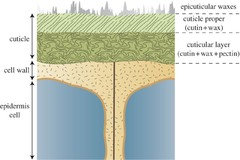
I hope you can see the picture. The top 3 layers are epicuticular waxes, cutin + cuticular waxes, and cutin + cuticular waxes + pectin. If you get the idea from the picture that cuticular waxes just might represent an important layer of protection for the plant - you're right, so please don't use dish soap as an insecticide. If you need to use a soap, use insecticidal soap, which is actually formulated to be hard on insects and soft on plants, but even these soaps have cautionary labeling to help the grower avoid hurtful (to plants) practices.Al
The Ficus Wrangler
8 years agoThanks, Al, for the explanation. But how do you explain the fact that I've used soap/water for insect control for over 25 years, with no harm to the plants? I mean, it's not an anecdote - I really have. If the soap is not too strong, it really works. And it doesn't seem to matter much what kind of soap you use, though I wouldn't feel comfortable using a strong grease-cutting detergent. The important thing is to use it weekly for 4 weeks. If anyone wants to try it, they should also find it works, with no harm to the plants. Have you ever tried it?
tapla (mid-Michigan, USDA z5b-6a)
8 years agoHow do you explain the guy who drinks a quart of hard liquor every day and claims it does him no harm because he's never had to see a Dr? If you do even a little research (other than reading the anecdotes of others), you'll find that dish detergents dissolve cuticular wax, which causes a number of problems that vary by what you use and how much. In the case of the guy & the quart of liquor, we know he's damaging his body - no matter what he thinks or says. If he reduces his intake to a pint per day, it doesn't change the fact he's damaging his body, only to what degree and how quickly. So it is with using dish soap on plants.
The better a particular brand or concentration of dish soap kills insects (and it varies widely), the worse it is for the plant because its function is the dissolution of organic waxes.
Al
Courtney Hayes
8 years agoSo I've left the pothos in the northern window so I wouldn't stress it more. I haven't watered it, and so many more leaves have been turning yellow and having little brown spots on the undersides of the leaves :( I don't know what to do to help it right now
tapla (mid-Michigan, USDA z5b-6a)
8 years agoAll you can do is give it good basic care at this point and monitor water needs carefully. As it loses leaves it will need less water, so use a wooden dowel or skewer stuck deep in the soil as a 'tell'. If it comes out stained dark by the soil or wet/cool between your finger tips, it's telling you to withhold water a while longer. Keep it warm and in very bright light - just not direct sun. Withhold fertilizer at least until you see signs of new growth.
Al
The Ficus Wrangler
8 years agoJust leave it be. Test the soil for moisture level to make sure it isn't too wet, because it will use less water in the lowered light. You can pull away the yellow leaves, but just leave the spotted ones, because they're still producing food for the plant. When you start to see some new growth, you'll know you're on the right track. Eventually when you have plenty of new growth, you can cut off the blemished leaves (cut or break the leaf stems flush with the main stem, so you don't leave stubs.) Remember that plants live at a slower rate than animals, so the changes you make won't have visible results for awhile.
Courtney Hayes
8 years agoOkay. Thanks you guys. I'm just a worrier. And it had been doing so good and growing so much for months! And then once I noticed it seemed sunburned in the south facing window, I moved it to the north window and it just seems to be getting worse. I hate seeing so many leaves yellowing. I've been picking them off at the end of their stems, flush wth the main stem. But now the plant looks so sparse and not full at all, in comparison. It's just bummed me out a bit
Courtney Hayes
8 years agoI've pulled most all of the damaged leaves off but I'll provide some pictures of the ones that are slightly damaged and still on the plant

Courtney Hayes
8 years agoThis is the plant. It looks better far away, and it used to be so much bushier and full looking. You can't really tell that it looks bare from this picture lol

Mentha (East TN, Zone 6B-7A)
8 years agoTry wrapping a few of them along the inside edge of the pot, they will root into the soil and at each node will produce a new plant. It also looks a tiny bit droopy. You might want to check the soil and water it if needed.
Courtney Hayes
8 years agoI will try that tomorrow! I checked the soil and could fit am entire finger in without the soil sticking to my finger much at all, so I watered it with purified watered and it's sitting in the sink so it can drain out and dry some while I sleep tonight.
Courtney Hayes
8 years agoI just don't understand all the brown spots. Should I be considering spider mites or is that too far fetched and paranoid?
Courtney Hayes
8 years agoWhile it is draining in the sink I noticed the undersides and their brown spots even more
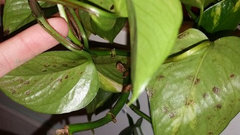
tapla (mid-Michigan, USDA z5b-6a)
8 years agolast modified: 8 years agoTo understand the spots, you need only remember the toxicity of the methyl salicylate in the wintergreen scented alcohol.
Al
Courtney Hayes
8 years agoI didn't figure even more would keep turning brown and yellow and me having to pull 12+ off :(
The Ficus Wrangler
8 years agoSpider mites almost never infest pothos. Besides, the damage they leave doesn't look like that. If you fear spider mites, you can shake the plant leaves over some white paper, and you will see the tiny bugs running around on the paper. Also you can pinch the leaves gently between your fingers, then wipe firmly - if you see little red or green smears on your fingers, you have spider mites.
The damage you're seeing is still from the spray; sometimes it just takes longer to appear on some leaves because those are ones that didn't get so much spray. Like I said before, when it gets it's "legs" under it and starts to make new leaves, it will fill out. Especially if you cut back any trailers that are bare at the base, then stick the cuttings back into the soil of the plant.
Mentha (East TN, Zone 6B-7A)
8 years agoSpider mites almost never infest pothos? Really? I think that really depends on where you live. Every pothos I had in California was infested with the little buggers. It has to do with dry air more than anything else. Pothis can get spider mites very easily in warm dry areas of the country especially in the winter where the humidity tends to be so low that almost all plants suffer.
The Ficus Wrangler
8 years agoYeah,that's why I said "almost." My experience is in NYC interiors (of course building interiors are notoriously dry, especially in the winter) and Florida. Mealy bugs are the pest we usually see on pothos.
If you were dealing with the plants in your home, that's an enclosed environment; once the mites get into a place they like, it gets harder and harder to dislodge them. If you're talking about a number of people with the same experience, and outdoors as well, I'd appreciate hearing about it - I'm always interested to learn of experience different from mine. And what did you do to control them?
Mentha (East TN, Zone 6B-7A)
8 years agoSpraying them with insecticidal soap then giving them a shower is the best way to combat the little buggers. I have also used Bronco fly spray with success and almost no damage to the plant.
The Ficus Wrangler
last yearWhen you say your pothos look like that, I kind of don't know what "that" you mean, since pictures of pothos on this question line are running back 10 years. Brown spots like some of those on this line are most likely caused by fungal infection, so the best - actually the only - treatment is to cut off the leaves. That way, if the disease is on the leaves, it won't spread. You don't give any info on care, or any pictures, so that's the best I can do. You might want to try sending pictures in to a FB group, like Houseplant Help, or Houseplant Hobbyists, or one of the other houseplant groups.
tapla (mid-Michigan, USDA z5b-6a)
last yearRe houseplants: most spoiled foliage is caused by physiological issues, over/under-watering, oedema, nutritional toxicities/ deficiencies, light levels, ...... with subsequent populations of fungi acting as opportunists as opposed to acting as causal agents. In this thread, oedema, a physiological disorder, is the main actor. Dead animals don't cause vultures, but they do provide a reason for vultures to congregate. IOW, lesions caused by physiological disorder often provide the consistently moist conditions for a period lasting long enough to ensure incubation and germination of fungal spores. This isn't to say that fungal conditions do not commonly appear in plants as pioneer pathogens, only that evidence of physiological disorder is far more common than direct evidence of pioneer populations of fungi.
Plant pathologists often describe the disease process using a 4-sided figure called the disease tetrahedron (think “pyramid – 3 sides + the bottom/ base”).

Each side of the tetrahedron represents an essential part of the infection process. There must simultaneously be a virulent pathogen (capable of infecting the plant) that is genetically capable of recognizing its host. Either the environment must be conducive to the development of the pathogen, or the pathogen must be able to stress/weaken the plant. The 4th requirement is the time required for diseases to develop and spread. Whenever conditions are such that any one (or more) of the 4 requirements is missing from the equation, there is no immediate threat.
Since the best medicines are prophylactic, the grower who makes sure plants are healthy and not stressed is ahead of the game. Biotic diseases are better able to overcome the natural defenses of plants weakened by stress that occurs when the plant is forced to deal with cultural conditions near, at, or beyond the limits the plant is genetically programmed to deal with.
Al

















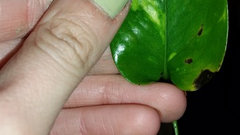
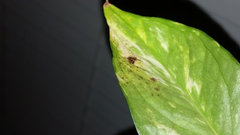


The Ficus Wrangler